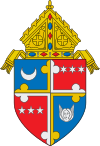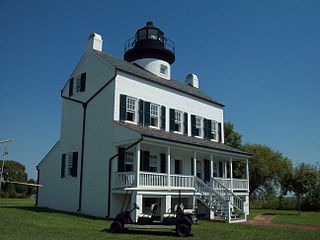
St. Mary's County, established in 1637, is a county located in the U.S. state of Maryland. As of the 2020 census, the population was 113,777. Its county seat is Leonardtown. The name is in honor of Mary, the mother of Jesus. St. Mary's County comprises the California-Lexington Park, Maryland Metropolitan Statistical Area, which also is included in the Washington-Baltimore-Arlington, DC-MD-VA-WV-PA Combined Statistical Area. It is part of the Southern Maryland region. The county was the home to the first Maryland Colony, and the first capital of the Colony of Maryland. Settled by English Catholics, it is considered to be the birthplace of religious freedom in North America, at a time when the British colonies were settled primarily by Protestants. The county is home to the Patuxent River Naval Air Station and St. Mary's College of Maryland. Traditionally, St. Mary's County has been known for its unique and historic culture of Chesapeake Bay tidewater farming, fishing, and crabbing communities. But with the advent of the military bases, growth of an extensive defense contractor presence, and the growth of St. Mary's College of Maryland, as well as increasing numbers of long-distance Washington, D.C. commuters, it has been undergoing a decades-long transformation which has seen the county's population double since 1970.
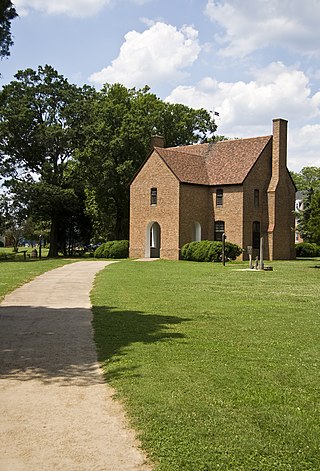
St. Mary's City is a former colonial town that was Maryland's first European settlement and capital. It is now a large, state-run historic area, which includes a reconstruction of the original colonial settlement, and a living history area and museum complex. Half of the area is occupied by the campus of the public honors college, St. Mary's College of Maryland. The area also contains a community of about 933 residents.

The Hon. Leonard Calvert was the first proprietary governor of the Province of Maryland. He was the second son of The 1st Baron Baltimore (1579–1632), the first proprietor of Maryland. His elder brother Cecil (1605–1675), who inherited the colony and the title upon the death of their father George, April 15, 1632, appointed Leonard as governor of the Colony in his absence.

Southern Maryland is a geographical, cultural and historic region in Maryland composed of the state's southernmost counties on the Western Shore of the Chesapeake Bay. According to the state of Maryland, the region includes all of Calvert, Charles, and St. Mary's counties and the southern portions of Anne Arundel and Prince George's counties. It is largely coterminous with the region of Maryland that is part of the Washington metropolitan area.

The Ammendale Normal Institute is a U.S. historic location in Beltsville, Maryland. Bought in 1880, it was a school and novitiate operated by the Institute of the Brothers of the Christian Schools. The Ammendale area is named after the previous owner, Daniel Ammen.

The First Unitarian Church is a historic church and congregation at 12 West Franklin Street in Mount Vernon, Baltimore, Maryland. Dedicated in 1818, it was the first building erected for Unitarians in the United States. The church is a domed cube with a stucco exterior. The church, originally called the "First Independent Church of Baltimore", is the oldest building continuously used by a Unitarian congregation. The name was changed in 1935 to "The First Unitarian Church of Baltimore " following the merger with the former Second Universalist Church at East Lanvale Street and Guilford Avenue in midtown Baltimore. The American Unitarian Association and the Universalist Church of America (established 1866) representing the two strains of Unitarian Universalism beliefs and philosophies merged as a national denomination named the Unitarian Universalist Association in May 1961.

St. Mary's Seminary Chapel, located at 600 North Paca Street in the Seton Hill neighborhood of Baltimore, Maryland, is the oldest Neo-Gothic style church in the United States. It was built from 1806 through 1808 by French architect J. Maximilian M. Godefroy for the French Sulpician priests of St. Mary's Seminary. Godefroy claimed that his design was the first Gothic building in America.

St. Ignatius Church is a Catholic church of the Archdiocese of Washington located at 2315 Brinkley Rd., Fort Washington, MD 20744, in Oxon Hill, Prince George's County, Maryland.
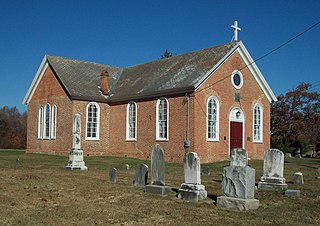
St. Paul's Church, also known as St. Paul's Church, Baden, or St. Paul's Parish, Prince George's County, is located at 13500 Baden-Westwood Road, in Baden, a community near Brandywine in Prince George's County, Maryland. It was originally constructed in 1733–1735. A porch on the north side was enclosed in 1769, and in 1793 an addition of 26 by 30 feet was made to the south side. The Bishop's Window, a memorial to Bishop Thomas John Claggett, is at the chancel window. In 1921 the sanctuary was widened and the chancel deepened.

St. Matthew's Church, also known as Addison Chapel, is a historic Episcopal church located at Seat Pleasant, Prince George's County, Maryland.

St. Thomas' Church is an Episcopal church in a rural setting, located at Croom, Prince George's County, Maryland. It is one of four congregations that have constituted the parish of St. Thomas in the Episcopal Diocese of Washington, the others including the Church of the Atonement in Cheltenham, the Chapel of the Incarnation in Brandywine, and St. Simon's Mission also in Croom.
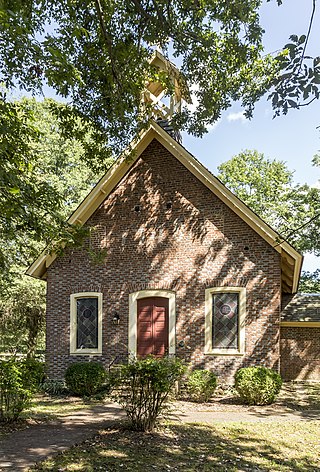
Middleham Chapel is a historic Episcopal church located in Lusby, Calvert County, Maryland. It is a one-story, cruciform, Flemish bond brick structure with exposed fieldstone foundations. It was built in 1748, to replace an earlier frame or log structure believed to have been erected as early as 1684, as a Chapel of Ease of Christ Church Parish. The date of construction is worked into the brick on the front of the church.

St. Andrew's Church is a historic church located at 44078 St. Andrew's Church Road, California near Leonardtown, St. Mary's County, Maryland. It was built in 1766 to serve as the parish church of St. Andrew's Parish, which had been established in 1744. It is a rectangular brick box church laid in Flemish bond with a gable roof and round-arched windows trimmed with brick segmental arches. At two corners stand two-story square brick towers with a diminutive spire. Richard Boulton designed the church in 1766; he was also responsible for the outstanding carving and ornamentation at Sotterley. George Plater (1735-1792), who briefly served as Maryland's governor before his death, was an active parish member, serving twenty-eight years as a vestryman.
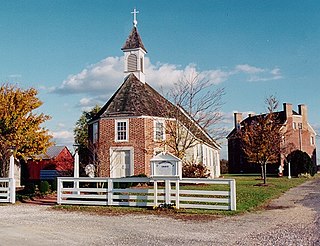
St. Francis Xavier Church and Newtown Manor House Historic District is the first county-designated historic district in Saint Mary's County, the "Mother County" of Maryland and is located in Compton, Maryland, near the county seat of Leonardtown. The district marks a location and site important in the 17th-century ecclesiastical history of Maryland, as an example of a self-contained Jesuit community made self-supporting by the surrounding 700-acre (2.8 km2) farm. The two principal historic structures were added to the National Register of Historic Places in 1972. Archaeological remains associated with the site date back to the early colonial period, mid-17th century.

St. Thomas Manor (1741) is a historic home and Catholic church complex located near Port Tobacco, Charles County, Maryland. Known as St. Ignatius Church and Cemetery, the manor house complex is the oldest continuously occupied Jesuit residence in the world. The mission settlement of Chapel Point was established in 1641 by Father Andrew White, S.J., an English Jesuit missionary. Father White ministered to the Potapoco Native Americans, some of whom he converted to Catholicism. Established in 1662, this is the oldest continuously active Roman Catholic parish in the American Thirteen Colonies. With the consecration in 1794 of Bishop John Carroll, St. Thomas became the first Roman Catholic see in the United States.
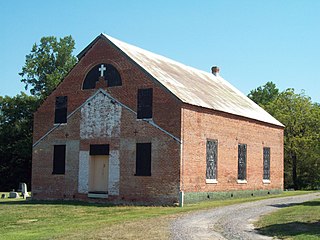
St. Mary's Catholic Church, Newport is a historic parish located in Newport, Charles County, Maryland, established in 1674. Several churches have been built on the property over its history. At present there are two churches remaining, one built in 1840, deconsecrated in 1906 and no longer used for religious services, and the current church building, built in 1954. The historic 1840 church is a rectangular brick structure, four bays in length and three bays wide. It is of simple architectural styling typical of the Greek Revival period in this locality. Located on the property is the parish cemetery, which includes the burial plot of the Brent-Merrick family, including congressman William Duhurst Merrick (1793–1857). It has several impressively scaled and ornamented monuments enclosed within a decorative mid-19th century wrought iron fence. Other memorial stones bear the signature of "A. Geddess," who founded the long-active Geddess monument firm of Baltimore in 1822.

St. James Church is a historic Episcopal church located at Monkton, Baltimore County, Maryland, US.

St. Ignatius Church is a historic Roman Catholic Church located at Forest Hill, Harford County, Maryland. It is a rubble stone, one-story rectangular structure of five bays, with a tall tower at the west end and a rubble stone two-story rectangular addition. The original 35 feet by 50 feet church was built between 1786 and 1792.
St. Inigoes, sometimes called St. Inigoes Shores, is a small, rural, unincorporated farming, fishing and crabbing community at the southern end of St. Mary's County in the U.S. state of Maryland that is undergoing a transition to small residential subdevelopment plots. Its western side is bordered by a number of coves and creeks that are connected to the St. Marys River, a brackish tidal tributary, near where it feeds into the mouth of the Potomac River and close to its entry point into the Chesapeake Bay.

St. Mary's College of Maryland, originally known as St. Mary's Female Seminary, began in 1840 as a secular state-sponsored boarding school for women. Since 1966 it has been a four-year public liberal arts college and in 1992 it became a designated public honors college. One of only two in the nation to hold such a distinction at the time.

























